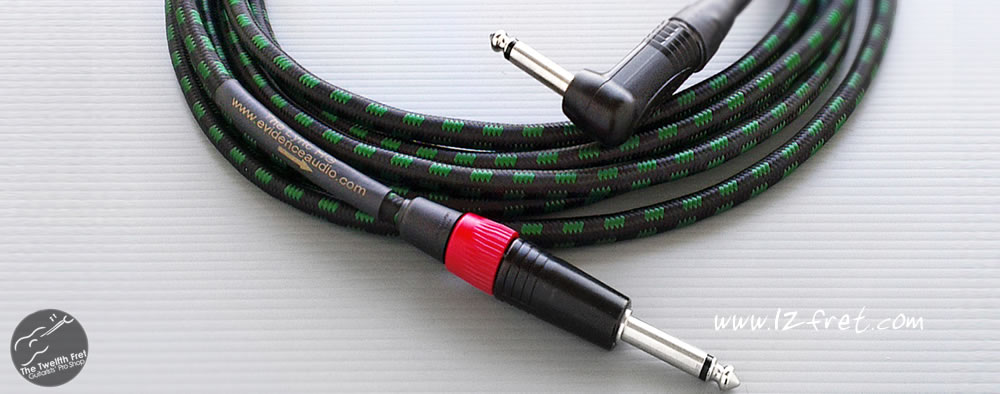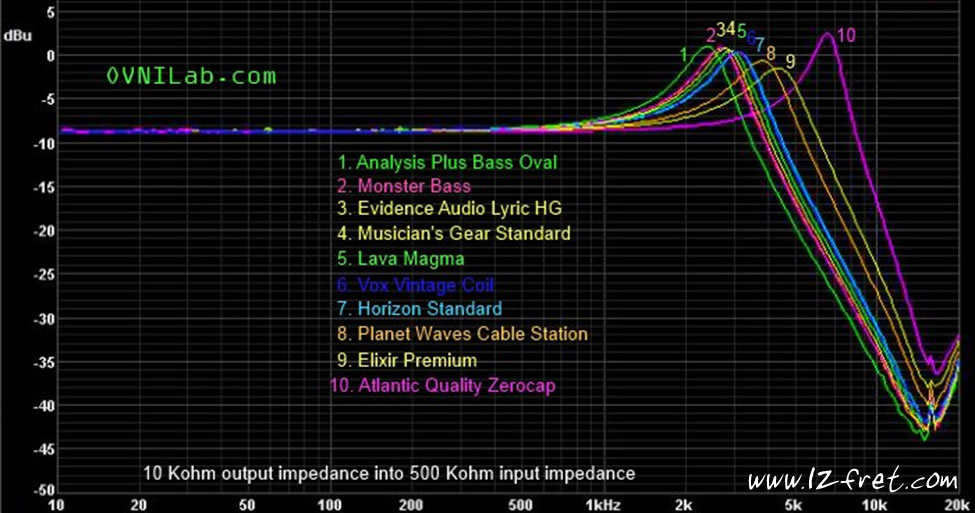
It’s a common question: “How much money should I spend on a guitar cable?”
Anyone in the market for a new cable will quickly discover a massive range in price. Surely, a $160 cable must be vastly superior to a $10 cable, right? Well, perhaps not.
Many high-end guitar cable makers will make bold claims about the tonal improvements provided by their cables. But “tone” is a tricky thing to compare. The way we hear can be very subjective. There’s also the well-known fact that our brains can play tricks on us. Someone who is expecting their guitar to sound better thanks to the $100 cable they just bought is likely to convince themselves that they can hear a difference, even if they can’t actually hear a difference at all.
Thankfully, a member of the TalkBass forums (bongomania) has decided to take subjectivity out of the equation, and is performing a series of spectrum analysis tests using various guitar cables. His initial findings are outlined in this post over at SFGuitarworks.com, while bongomania himself has posted some revisions with updated results as he refines his testing techniques. The results are eye-opening, to say the least. It is worth reading both articles linked above for all the details, but I’ll do my best to summarize the key points:
- Guitar cables are inherently passive, meaning they cannot possibly “add” anything to your guitar tone. All they can possibly do is subtract from your signal. So any cable maker that claims their cable will “add bass” or give you “warmer midrange” is, at best, bending the truth. Their cable may be removing trebles, therefore creating the impression of “more bass”. But they are not adding anything to your sound.
- Gold tips on your cables do not conduct the signal any better than standard tips. Gold resists corrosion, which is nice for the longevity of the cable, but provides no tonal improvements.
- The only factor that actually effects the tonal transmission of a guitar cable is the cable’s “capacitance”, because that determines how much of the current coming out of your guitar makes it all the way through to your amp, and how much stays in the cable.
So in terms of comparing how different cables “sound”, the capacitance of each cable is the only difference that really matters.
Now let’s take a closer look at the results of bongoman’s tests.

The line you see in the graph above is actually 10 lines stacked right on top of each other. Each line represents a frequency analysis of a different guitar cable, ranging in price from roughly $9 USD all the way up to $160 USD. That’s right; the 10 different cables are virtually identical in their ability to transmit a signal. Under these test conditions, they sound the same.
But bongomania didn’t stop there. Like any good scientist, he decided to refine his test to see if there were any subtle differences he had missed.
I’ll spare you the technical details, but simply put, his initial test was an accurate representation of an active signal, running through each of the 10 cables, into a guitar amplifier. So if you are playing a guitar or bass with an onboard active preamp, then the graph above will prove accurate for you; you won’t hear any difference between cables. However, most guitars on the market are not active… they are passive. A passive instrument puts out a far weaker signal than an active instrument. So bongomania tweaked his test to replicate the output strength of a passive guitar:

Do Expensive Guitar Cables Really Sound Better?
Now, we’re starting to see some differences between guitar cables. This is because the output signal of a passive guitar is so weak that the slight differences in the capacitance of each cable are making an impression. We can see that all 10 cables in this test show a slight bump in the lower-treble frequencies, before diving off a cliff in the upper-treble frequencies. All 10 cables are losing some high-end frequencies, some a little more than others. But this is where the test results get really interesting; look at where each of the 10 cables rank in terms of treble-loss. The Monster Bass, Evidence Audio Lyric HG, and Lava Magma are 3 of the most expensive cables on the list, yet none of them transmit treble frequencies as well as the $9 Horizon Standard cable. The Elixer Premium cable and Planet Waves Cable Station (a solder-less cable kit) are some of the better-performing cables on the list, and are both modestly priced. The best-performing cable on the list, the Atlantic Quality Zerocap, actually has a battery-powered buffer box built right in to the cable, so it’s no surprise that it suffers less treble loss than any other cable in this test.
To be fair to some of the higher-priced cables on the market, there are other differences that we aren’t covering here. Some cables have thicker shielding, or more durable construction. Those are very real differences, and often worth paying a bit extra for. But when it comes to the audio quality of a guitar cable, don’t let the marketing fool you. There is very little difference in sound from one cable to the next, and the more expensive cables are not necessarily on the winning end of that comparison.
